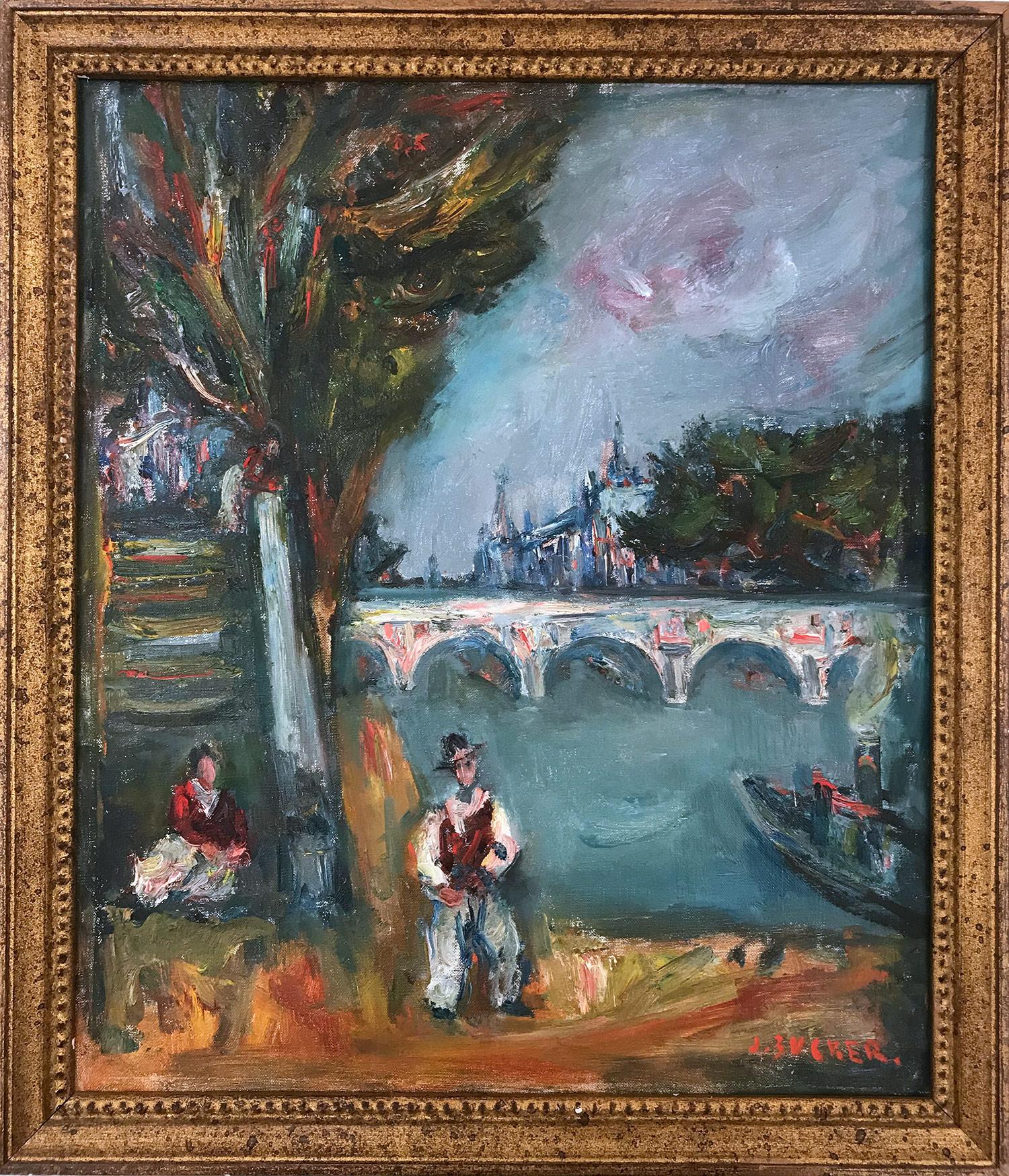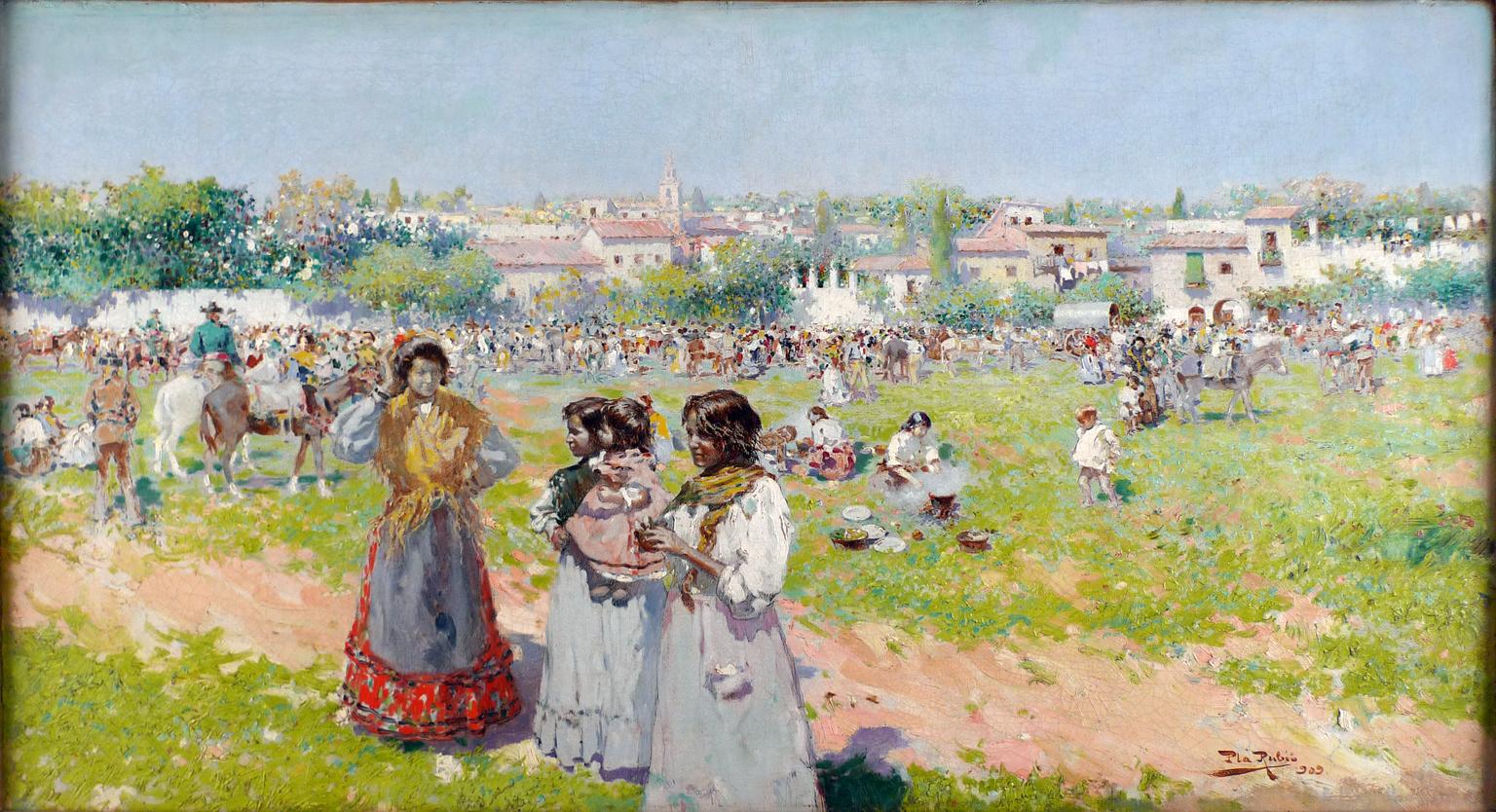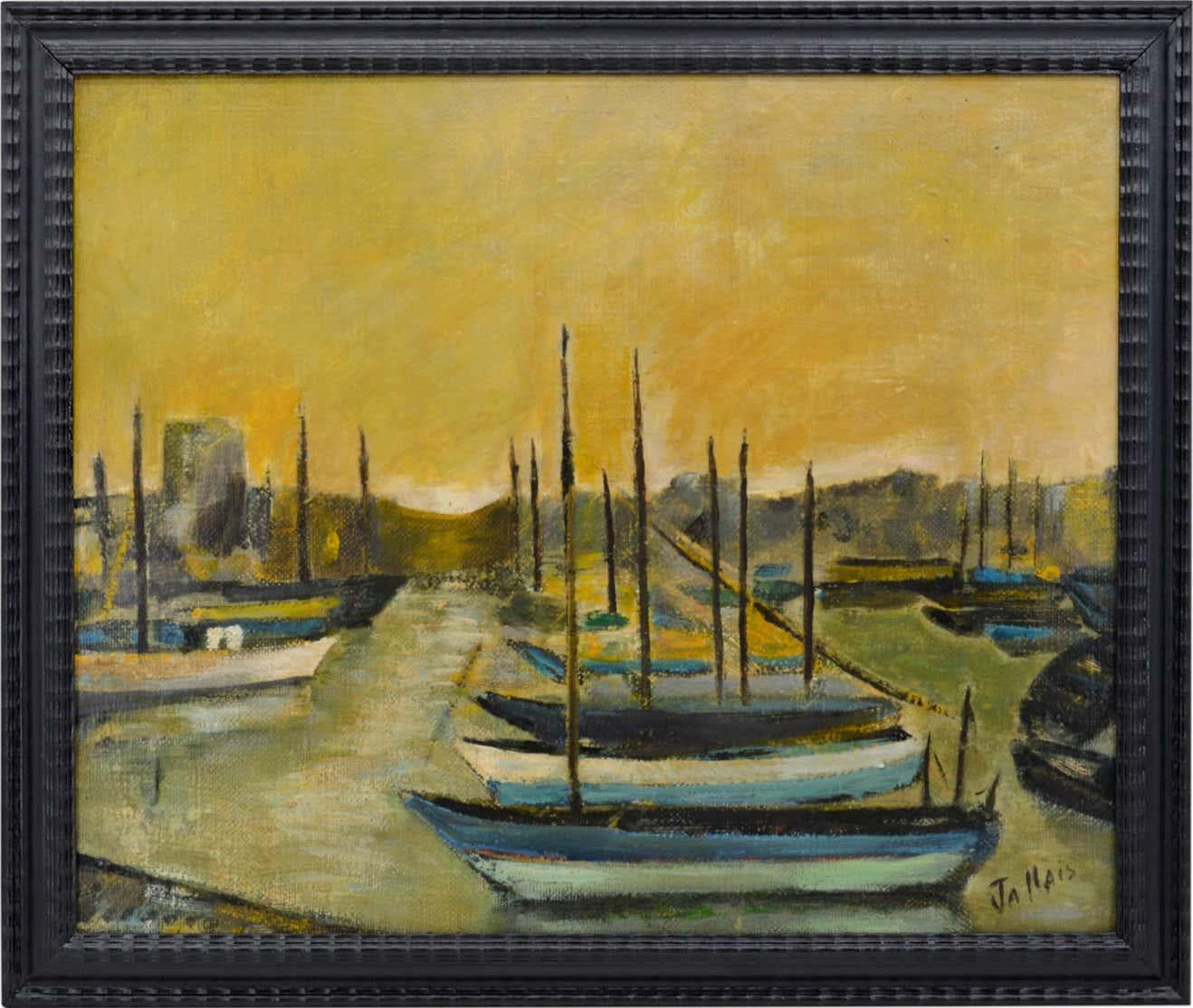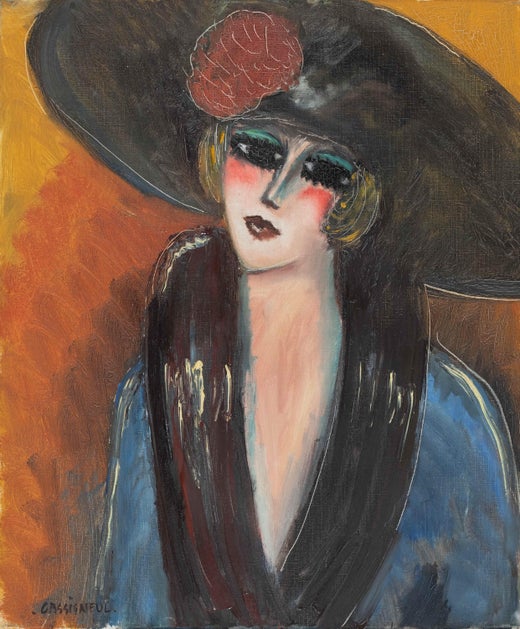Jean-Pierre CassigneulOctobre by Jean-Pierre Cassigneul
About the Item
- Creator:Jean-Pierre Cassigneul (1935, French)
- Dimensions:Height: 35.38 in (89.87 cm)Width: 31.13 in (79.08 cm)Depth: 2 in (5.08 cm)
- Medium:
- Movement & Style:
- Period:
- Condition:
- Gallery Location:New Orleans, LA
- Reference Number:
Jean-Pierre Cassigneul
Jean-Pierre Cassigneul is a French painter known for his serene portraits of women in hats that recall the French Post-Impressionist avant-garde, including the works of Pierre Bonnard and Edouard Vuillard.
Cassigneul was born on July 13, 1935, in Paris. He studied at the École des Beaux-Arts in Paris and went on to exhibit in various group exhibitions, including the Salon d'Automne in Paris (of which he was member), the Salon de la Jeune Peinture and more. Cassigneul exhibited at the Beaubourg Center in Paris in 1977 and solo as of 1952, on a regular basis in France but also in New York, and Tokyo and worldwide.
Cassigneul is known for his charming and extremely popular Van Dongen–influenced paintings of women in floral hats, complete with frequent allusions to other aspects of the Années Folles. His first solo exhibition was at the Galerie Lucy Kroge in Paris when he was 17 years old.
Find a collection of Jean-Pierre Cassigneul prints on 1stDibs.
(Biography provided by Joseph Grossman Fine Art)
- ShippingRetrieving quote...Ships From: New Orleans, LA
- Return PolicyThis item cannot be returned.
- La lecture au jardin (Lesson in the Garden)By Georges d'EspagnatLocated in New Orleans, LAFrench Post-Impressionist painter Georges d’Espagnat captures a charming moment between a mother and her child in this vibrant oil on canvas. Rendered with a studied use of complementary colors and bold brushstrokes, the painting showcases the artist's unique Post-Impressionist style. Remembered as one of the most individualistic artists of the 20th century, his distinctive canvases bring together the loose brushwork of the Impressionists and the bold color palette favored by the Fauves. Together, they achieve a vibrant spontaneity that lends itself well to the carefree subjects of the present work. Masterfully composed, La lecture au jardin moves beyond the Impressionist instinct to capture a fleeting moment on canvas. Rather, d'Espagnat succeeds in creating a deep feeling of harmony in the work. Warm colors are perfectly balanced with cool tones, while vertical and horizontal lines are softened by the curves of the foliage and his subjects' figures. Through his simplification of forms and intentional use of color and line, he creates a scene that is carefully designed and thoroughly modern. A similar view of a mother and her child by d'Espagnat is currently in the collection of the Metropolitan Museum of Art (New York). The Post-Impressionist painter was an individualist since his youth, choosing to forgo traditional schooling in order to independently study the Old Masters in the Louvre. He soon became involved with the most prominent Impressionist and Post-Impressionist painters of the age, including Pierre-Auguste Renoir and Paul Signac, who themselves existed outside the traditional norms of French Academic training. In 1891, he exhibited at the Salon des Refusés, and again the following year at the Salon des Indépendants. By 1895, he held his first one-man show in Paris, and just three years later his success earned him a solo show at the prestigious Durand-Ruel Gallery. Between 1905 and 1910 he made several trips to visit Renoir on the Côte d’Azur. Their close friendship resulted in a group exhibition at Marcel Bernheim...Category
Late 19th Century Post-Impressionist Portrait Paintings
MaterialsCanvas, Oil
- Le bouquet dans les bras by Jean-Pierre CassigneulBy Jean-Pierre CassigneulLocated in New Orleans, LAJean-Pierre Cassigneul b.1935 French Le bouquet dans les bras (The bouquet in the arms) Signed “Cassigneul” (lower right) Signed, titled and dated "Le bouquet dans les bras / Cass...Category
21st Century and Contemporary Post-Impressionist Figurative Paintings
MaterialsCanvas, Oil
- L’air Qu’on Respire by Jean Pierre CassigneulBy Jean-Pierre CassigneulLocated in New Orleans, LAJean-Pierre Cassigneul b.1935 French L’air qu’on respire (The Air We Breath) Signed “Cassigneul” (lower right) Signed, titled and dated "L’air qu’on respire / Cassigneul / 2001" (...Category
21st Century and Contemporary Post-Impressionist Portrait Paintings
MaterialsCanvas, Oil
- Le carnaval du sage by René MagritteBy René MagritteLocated in New Orleans, LARené Magritte 1898-1967 Belgian Le carnaval du sage (The Sage’s Carnival) Signed “Magritte” (lower right); titled and dated "Le carnaval du sage 1947" (en verso) Oil on canvas The enigmatic paintings of René Magritte have become some of the most familiar and celebrated of the Surrealist movement. Among the most influential of the Surrealist painters of the 20th century, Magritte is an artist of international renown, as beloved for his popular appeal as he is for the psychological intensity of his works. The present oil on canvas, entitled Le carnaval du sage, was executed in 1947 at the height of his career, and it is a tour-de-force example of the haunting, mysterious scenes that comprise his oeuvre. Painted in the years following the Second World War, Le carnaval du sage showcases several recurring themes from Magritte’s oeuvre. Chiefly, a juxtaposition between the visible and the hidden is keenly felt. Throughout his career, Magritte explores the psychological obsession with revealing what is hidden, particularly with regard to the human face. In his Le fils de l’homme, he obscures the face of a man in a bowler hat with an apple, while his Les amants (Metropolitan Museum of Art) conceals the faces of two lovers with white sheets. In Le carnaval du sage, Magritte juxtaposes the blatant nudity of his central figure by masking her face, simultaneously revealing and concealing her from the viewer. The work also incorporates two of Magritte’s most common tropes – the glass of water and the baguette. Lending the scene a strange sense of domesticity, they appear infinitely familiar and distinctly out of place, and thus heighten the uncanny effect of Magritte’s composition. In the background hovers a ghost obscured by a sheet, a figure which was of particular fascination to Magritte beginning in 1946. He once wrote to his fellow Surrealist Paul Nougé: "I saw in a dream an answer to the problem of the ghost: the traditional ghost draped...Category
20th Century Post-Impressionist Nude Paintings
MaterialsCanvas, Oil
- La Terrasse Devant La Mer By Jean Pierre CassigneulLocated in New Orleans, LAJean-Pierre Cassigneul b.1935 French La terrasse devant la mer (The Terrace by the Sea) Signed “Cassigneul” (lower left) Oil on canvas laid on panel This monumental, three-panele...Category
20th Century Post-Impressionist Figurative Paintings
MaterialsCanvas, Oil, Panel
- La Petite Swan By Ramon DilleyLocated in New Orleans, LARamon Dilley 1933 - Spanish La Petite Swan Signed “Dilley 91” (lower right) Signed and titled “Ramon Dilley / La Petite Swan” (en verso) Oil on board laid on canvas This captivat...Category
20th Century Post-Impressionist Figurative Paintings
MaterialsOil, Canvas, Board
- "Parisian Scene by Pont Neuf with Notre Dam" French Impressionist Oil PaintingBy Jacques ZuckerLocated in New York, NYThis painting depicts a landscape scene of a Parisian Scene by Pont Neuf with Notre Dam in the distance behind the bridge. The attractive perspective is what makes this painting so i...Category
20th Century Post-Impressionist Landscape Paintings
MaterialsOil, Canvas
- Place de la République, 20th Century Oil on Canvas by Edouard Léon CortèsBy Édouard Leon CortèsLocated in Madrid, ESEDOUARD LÉON CORTÈS French, 1882 - 1969 PLACE DE LA RÉPUBLIQUE signed "EDOUARD CORTÈS." (lower right) oil on canvas 25-3/4 x 36-1/4 inches (65 x 91.5 cm.) framed: 33-1/2 x 44-1/4 inc...Category
1930s Post-Impressionist Figurative Paintings
MaterialsOil, Canvas
- "At the Annual Fair", an early 20th Century oil on canvas by Alberto Plá RubioLocated in Madrid, ESALBERTO PLA Y RUBIO Spanish, 1867 - 1937 AT THE ANNUAL FAIR signed & dated "Pla Rubio, 909" (lower right) oil on canvas 14 X 25-5/8 inches (35.5 X 65 cm.) ...Category
Early 1900s Post-Impressionist Landscape Paintings
MaterialsCanvas, Oil
- Henri-André Martin Road in Eygalieres, Alpilles, Provence, Oil on Canvas, 1999By Henri-André MartinLocated in Saint Amans des cots, FROil on canvas by Henri-André Martin (1918-2004), France, 1999. Road in Eygalieres, Alpilles, Provence. With frame: 52x67 cm - 20.5x26.4 inches. Without frame: 46x61cm - 18.1x24 inches. Format 12P. Signed and dated lower left "Henri-André Martin 99" (see photo). Located on the back (see photo). Can be matched to make a pair with another painting by Henri-André Martin that we offer on 1stdibs whose title is "Henri-André Martin Road in the Alpilles, Provence, Oil on Canvas, 1980s". Born in Lyon in 1918, the child and the adolescent Henri-André Martin spent his youth in Saint-Étienne, his father, Edme Martin, first installed as a practicing doctor in Lyon, having been appointed doctor of the anti-tuberculosis dispensaries of the Loire. During his first years of studying medicine in Lyon, he nevertheless enrolled in the Beaux-Arts. Appointed hospital intern upon his return from captivity in 1942, he ended his medical career as director of the otolaryngology university clinic at Édouard-Herriot hospital. But painting was his passion. Painting was for Henri-André Martin the way of expressing his feelings. By nature very reserved and of an extreme modesty that many took for coldness, it was what allowed him to express his strong artistic sensitivity and, his pictorial periods are as many reflects of his anxieties, of his hopes, of his joys. At every period of his life, wherever he goes and whenever he has a moment, he paints gouaches, often of small size, but sometimes of larger size. He also paints beaches that have been compared to those of Boudin. Their invoice shows, however, that this figure is only appearance and that in fact, these beaches made of water, sky and sand, readily dispense with the motif, the work of the material seeming to have more importance. as the subject. Despite the fact that until the 1970s he painted "on the ground", his canvases remain far removed from the anecdote. Often harsh like the landscapes of Provence, the Parisian walls which express concern, or the railways, the switch tracks which suggest, in ocher and black, all the embarrassment of choice. We find the same nostalgic gravity in the canvases of the carcasses of boats which, as his friend Louis Pons later wrote, "seem to die of immobility" or in the canvases of Venice, or the landscapes of Eygalières. In the following years, his painting became simpler, more synthetic, such as these landscapes with tortured almond trees, black and gnarled olive trees, plane trees standing out against the ocher sky of the dawn of Provence, in winter. These are also the canvases of Hamburg in the dough becomes heavier, the colors darken, marking all the gravity of the port landscapes. Workshop work gradually takes precedence over motif painting. The pivotal period coincides with that of his work on the olive tree, during which he leads the realization of the "Trunks", a collection of six lithographic plates, of the book L'olivier comprising many lithographs and serigraphs, but also texts. poetic and numerous paintings. He then became passionate about everything related to the olive tree (literature, painting, traditions, history), but also to the tree itself, its thousand-year-old history, its poetry, its symbols, but also its culture, its size. oil production...Category
1990s Post-Impressionist Figurative Paintings
MaterialsCanvas, Oil
- Oil on Canvas by Jallais, Boats in Port, 1960sLocated in Saint Amans des cots, FROil on canvas by Jallais, France, 1960s. Boats in port. In its pretty dark brown wooden frame. With frame: 68x58 cm - 26.8x22.8 inches, without frame: 61x50 cm - 24x19.7 inches. 12F ...Category
1960s Post-Impressionist Figurative Paintings
MaterialsCanvas, Oil
- Maria Van Rysselberghe au coin du feuBy Theo van RysselbergheLocated in Palm Desert, CA"Maria Van Rysselberghe au coin du feu" is a portrait painting by Post-Impressionist Théo van Rysselberghe. The portrait is signed lower right, "Atelier Van Rysselberghe". The framed...Category
1910s Post-Impressionist Portrait Paintings
MaterialsCanvas, Oil
Recently Viewed
View AllRead More
Wear Louis Comfort Tiffany’s Genius on Your Finger with This Vivid Ring
In his jewelry making, the designer rarely used diamonds — this rare example has two.
You Won’t Find a More Handsome Stopwatch Than This 1890s Pocket Chronograph
A Grand Complication from the golden era of pocket watches, the Marius Lecoultre pocket watch does everything but uncork your wine.





